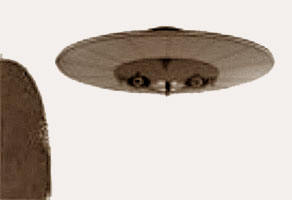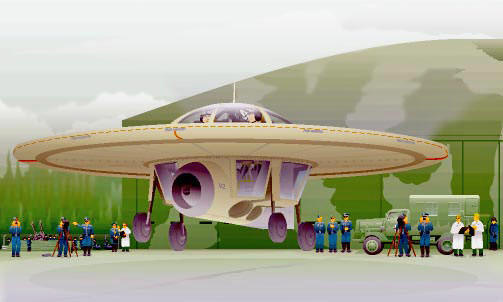|


|

Possible constructed BMW Flugelrad
II V-2 in flight, April 1945
Powered by underbody BMW 003 turbojets |
|


Drawing by Richard Lewis Mendes
|

by Rob Arndt
1943
BMW Flugelrad I V-1 was painted matte aluminium and performed its first
flying test at the Czech Aerodrome at Prag-Kbely between August and
September. It left the hanger by its own means, the rotor began to spin and
the machine lifted to 1 meter and flew for 300 meters before making a hard
landing. During static tests the prototype was surrounded by concrete blocks
to protect the crew in the event of a disc blade breaking. In appearance the
basic Flugelrad lay-out was of a central body housing a pilot covered by a
hemispheric dome surrounded by a disc blade rotor of 6 meters with a lower
body housing a BMW 003 jet engine, fuel, a Strahlrohr jet deflector and
fixed landing gear of 4 legs fitted with wheels (with no brakes nor shock
absorbers). Flight was achieved by jet exhaust deflection into the 16
variable-pitch disc blades with hydropneumatic actuators.
1944
Several changes were introduced on the second prototype designated BMW Flugelrad I V-2. The cockpit was enlarged to carry two crew and serve as
support for the addition of an aerodynamic rudder. The fixed landing gear
was replaced with a more practical semi-retractable one. Rotor diameter was
enlarged to 8 meters but kept the 16 disc blades. The machine was painted
yellow and performed its first flight tests in the autumn of 1944 at the
Neubiberg Aerodrome near BMW's Munich facility. Stability problems continued
to plague the machine.
1945
The next prototype, BMW Flugelrad II V-1, kept the same body but discarded
the failed rudder, which proved almost useless. The rotor was enlarged to
12.6 meters. The first flight was at Prag-Kbely in February 1945 with
another jump at low altitude. Three other Flugelrad models were under study
in early 1945:
-
the BMW Flugelrad II V-2 under construction
-
the BMW Flugelrad II V-3 models
-
the BMW Flugelrad III design phase
Both the
BMW Flugelrads II V-2 and V-3 would have used two BMW 003 engines in the
lower body side-by-side, enlarged cockpits for four crew, and rotor
enlargement to 14.4 meters (although the V-2 would have had 24 disc blades
while the V-3 would have had 21). The final BMW Flugelrad III would have
been the production aircraft- a huge stratospheric recon aircraft powered by
two BMW 018 engines each with twin Strahlrohrs mounted one above the other,
an upper and lower cockpit arrangement, 6 crew, enlarged 24 meter rotor with
32 disc blades, fully retractable gear, and room for an array of recon
cameras. Nevertheless, all work ceased on the Flugelrads in April 1945. All
prototypes and documentation were destroyed in the Russian advance.

|

